For more than two thousand years, mankind has been trying to solve all of these severe dermatosis problems, but much remains unknown. According to statistics, the disease strikes from 4 to 7% of the population, women and men are equally susceptible to it. The first signs of psoriasis usually appear during puberty and accompany a person for the rest of his or her life, then subside and disappear completely, then worsens.
Can psoriasis be cured?Modern medicine has achieved many successes in the treatment of this chronic dermatosis and is able to give patients a good level of quality of life.
Causes of psoriasis
Psoriasis is a chronic inflammatory process of the skin, referred to in modern medicine as autoimmune (related to allergies to a person’s tissues). There are many causes of psoriasis and factors that lead to the development of this dermatosis, which are related to a number of theories of its origin.
Autoimmune
This is a key theory, as it has been proven that the immune system actively responds to certain types of skin exposure. The skin of people suffering from psoriasis is very sensitive to mechanical, physical, and chemical influences. It is not just the epithelial cells that respond to such influences, but the entire immune system.
Impaired cellular immunity: the ratio between individual subtypes of lymphocytes responsible for the formation of a normal immune response. Thus, in psoriasis, the number of helper T-lymphocytes increases-helper regulates immunity, while the number of suppressor T-lymphocytes, suppressing an overly strong immune response, decreases. Lymphocytes and some other cells produce cytokines - active substances that stimulate the immune response. Humoral immunity also suffers, an imbalance of antibodies (immunoglobulins) in the blood serum develops, antibodies to the tissues of the patient's body appear.
Inflammation begins against the background of activation of T-lymphocytes, but why they are activated is not yet known. In the research process is also the question of how to suppress the autoimmune response without harming the patient.
Exchange
Metabolic imbalances have significant effects on skin and immunity. In patients with psoriasis, there is an acceleration of metabolism, the emergence of large amounts of toxic free radicals and other toxins that support the inflammatory response. Disturbed metabolism:
- proteinaceous- CDSN predisposing gene stimulates the synthesis of corneodesmosin protein, which thickens the body (allergenic); albumin protein content in the blood decreases and globulin content increases; this condition is called dysproteinemia and in turn increases sensitivity;
- fatty- increased lipid and cholesterol content in the blood; consumption of plant foods especially and a decrease in caloric content in the daily diet can reduce the activity of psoriatic inflammation;
- carbohydrates- almost always violated;
- exchange of vitamins and minerals- the content of vitamin C in the skin increases, the content of vitamins C, A, B6, B12, iron, copper and zinc in the blood decreases.
Infectious
This theory was relevant in the early and mid -last century. Certain bacteria (streptococcus), fungi and viruses are considered to be the causative agents of psoriasis. These theories have not been confirmed. But dermatologists note that any acute infectious process or the presence of a permanent focus of infection can cause a relapse. Viral theory occupies a special place. Recent studies show the effect of retroviruses (RNA -containing viruses - HIV, etc. ) on genetic tools with the formation of genes for psoriatic predisposition.
Genetics
The tendency for autoimmune reactions is inherited. If your loved ones suffer from psoriasis, then the chances of contracting the disease increase many times over. There are genes for susceptibility to psoriasis (local complex PSORS1-PSORS9, PSORS1 is very active, it contains genes HLA-C, HLA-Cw6, CCHCR1 and CDSN, which are responsible for the development of the disease). Genes affect metabolism, immunity and the development of autoimmune processes. But the presence of such genes in no way guarantees the development of the disease. The influence of provoking factors is very important.
Neurogenic
Prolonged stress, high neuropsychic stress, disorders of the autonomic nervous system (activating the walls of blood vessels and internal organs) can lead to the development of psoriasis, causing imbalances of the endocrine system, disorders of metabolic and immunological processes.
Endocrine
Endocrine disorders in psoriasis are common and primarily play a role as a provoking factor. A clear relationship between the two has not been proven. Dermatologists note that patients often experience dysfunction of the thyroid gland, adrenal glands, and pituitary gland. There are menstrual irregularities in women and sexual function in men.
Symptoms of psoriasis
The main symptom of psoriasis is a skin rash. But there are other signs as well. The first manifestations usually appear in adolescence or childhood with a background of hormonal disorders, vegetative-vascular dystonia and prolonged stress.
The disease begins with a feeling of constant fatigue, mood disorders. Characterized by small (pink colored) formations towering high above the surface, powdered from above with whitish exfoliation. They are surrounded by brighter and towering edges.
The elements of the rash grow and merge into large plaques of strange shapes. The base of the papule is an inflammatory infiltrate. By the nature of the rash, psoriasis is divided into:
- point- elements with a diameter of not more than 1mm;
- tears- papules-droplets up to 2 mm;
- coin -shaped- round pieces up to 5 mm.
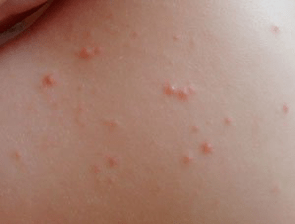

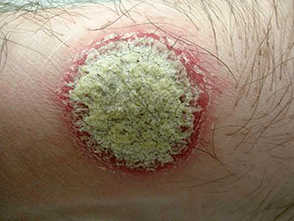
Typical features of the rash:
- stearin stain- if you scrape, the surface of the papule;
- terminal film- By thoroughly cleaning the surface of the papule, we will see a transparent film;
- blood dew (Auspitz phenomenon)- after scraping the film and breaking its integrity, we will see small drops of blood on the surface.
Stages of psoriasis
There are three stages of the disease:
- progressive- the first rash element appears, the number increases, all new areas are captured; rash also appears when scratching itchy skin or exposed to some external irritating factors (Kebner phenomenon); in the early stages of psoriasis, papules begin to merge into large plaques;
- still- there are no new elements, and previously appearing elements do not go back;
- regressive- the rash becomes pale, the base becomes less dense; the rash gradually recedes, the process often starting from the middle part, until the plaque can be ring-shaped; if the plaque on psoriasis dissolves from the periphery to the center, then gradually its size decreases and a white ring is formed around it - the pseudoatrophic rim of Voronov; where there is a rash, white, permanent pigmented areas - psoriatic leukoderma.
Occasionally, papules appear on the skin simultaneously in all three stages of development. There are also summer and winter forms with a predominance of exacerbations in summer or winter.
Is psoriasis contagious?
Many studies have confirmed that this is not a contagious disease. If an infectious pathogen participates in its development, then only through general effects on metabolism, immunity and genetic tools.
Patients often ask:
- How is psoriasis spread?
Psoriasis is not spread from person to person.
- Is psoriasis inherited?
The answer is again negative, but there is a hereditary tendency in the form of metabolic characteristics and functions of the immune system, which is passed on to close relatives.
Types of psoriasis
The nature of the rash, their location, damage to other organs and systems in this chronic dermatosis may vary. According to these signs, several types of disease are distinguished.
Simple (vulgar, plaque)
The most common. The symptom is a papule with a distinctive bright pink color, covered with white scales. Downstream, plaque psoriasis is divided into the following forms:
- Happy- if the lesion covers the skin no more than 3%; in the progressive phase, the papules increase, but then they undergo rapid development;
- simple- rash lasts between 3 to 10%; large papules, merging into plaques;
- heavy- defeat earns more than 10%; the rash is numerous, merging, forming various forms.
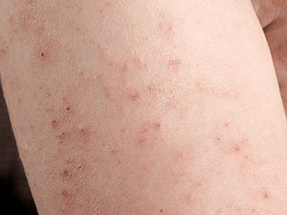
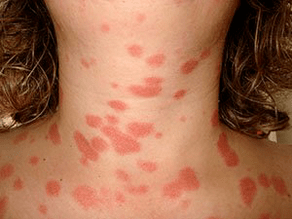
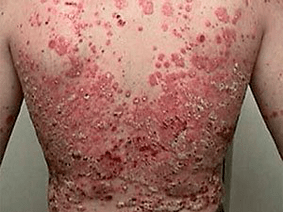
Psoriasis vulgaris occurs in the form of relapses, alternating with remission, but there is also a continuous course
Psoriasis of the elbow
This is one of the manifestations of a mild form of plaque inflammation. A hallmark of psoriasis of the elbow is the persistent presence of one or more "task" plaques in the extensor portion of the elbow joint. If these elements are injured, exacerbations will begin.
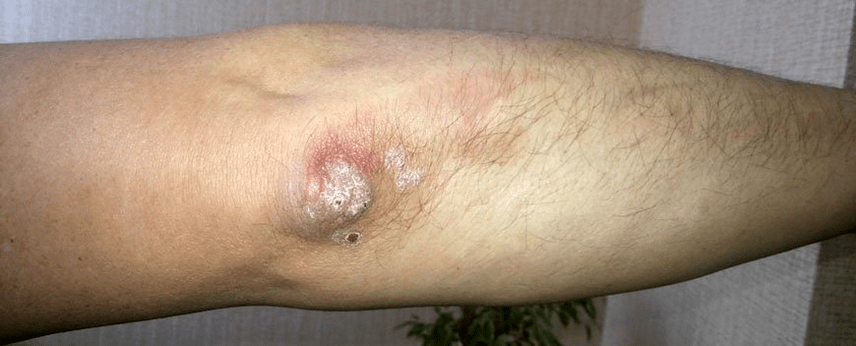
Intestinal psoriasis
In the development of guttate psoriasis, bacterial (most often streptococcal) and viral infections are very important. Occurs in childhood. Inflammation begins after infection. Streptococci release toxins (antigens - substances foreign to the human body) that bind to tissue proteins. Antibodies are produced to them and autoimmune inflammation develops.
The onset is acute. On the skin of the feet (more rarely the body and face), small red papules — tears with a flaky surface appear. With injury to the rash area, erosion and small wounds form, the risk of infection increases.
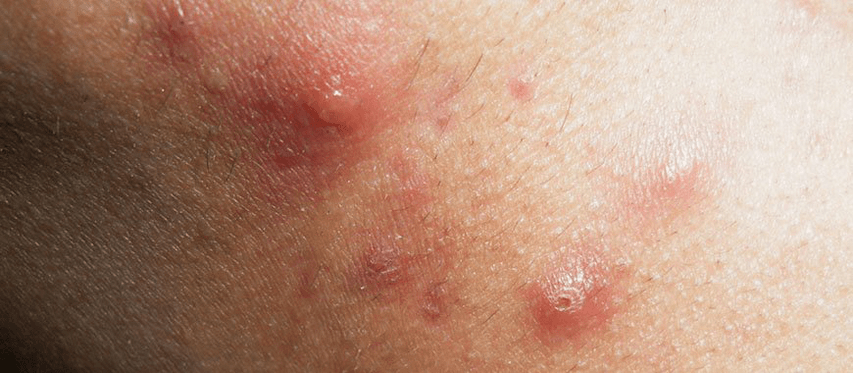
Psoriasis rapidly undergoes a subacute and chronic course. Relapse replaced by remission, independent recovery or transition to an adult form of the disease is possible.
Palmar-plantar psoriasis
It develops in those engaged in physical work, is accompanied by severe itching and almost always causes complications on the nails. There are subspecies:
- fan -shaped plaque- with large elements on the palmar and plantar surfaces, covered with white scales, merging into fan -shaped plaques; such psoriasis on the hands is more common;
- circular- ring -shaped scaly elements on the palmar and plantar surfaces;
- Moths- characterized by coarse epithelial growth with corn formation;
A separate subspecies is pustular psoriasis of the palms and soles of the feet of Barber. The area under the big toe is covered with vesicles and pustules (with purulent contents), severe itching appears. The abscess joins, then dries, forming a crust. Elsewhere in the body, characteristic psoriatic elements develop. The disease often spreads to the nails.
Psoriasis on the legs is maintained and exacerbated by varicose veins, in which case the rash will occur mainly in the lower leg area.
Nail psoriasis
Damage to the nails can be independent or complication. Typical symptoms:
- small dimples with different depths appear on the nail plate; similar nail lesions are found in other dermatitis, but in psoriatic lesions they are deeper and less painful when pressed;
- spontaneously slow painless nail separation (onycholysis);
- subungual bleeding on the toenails, especially if the patient wears tight shoes;
- trachyonychia - turbidity and aberrations on the nail plate; depression forms in the center of the nail and the nail becomes spoon -like (koilonychia).
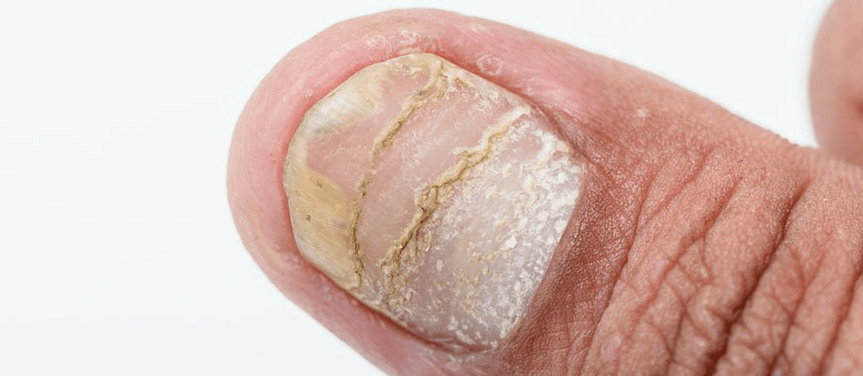
Sometimes the periungual roller is affected by the transition of inflammation to other tissues (psoriatic paronychia).
Scalp psoriasis
Here, the disease progresses independently or as part of a general pathological process. Characterized by the removal of water, the formation of crusts on part or all over the surface of the head. Hair growth is not affected at the same time: psoriasis on the head does not interfere with the function of the hair roots. But urinating poses a threat of infection with subsequent damage to the hair follicles.
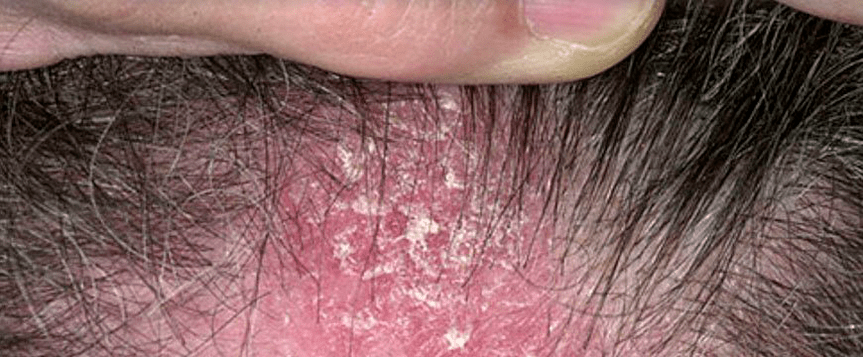
It flows in waves, then subsides with loss of crust, then worsens and is accompanied by severe itching, which often causes the patient to develop neurosis.
Seborrheic psoriasis
Seborrhea is a condition caused by damage to the sebaceous -producing skin glands. Viscous oils are produced, irritate the skin and contribute to the development of inflammation - dermatitis.
Seborrheic psoriasis quickly spreads throughout the head, covering it in the form of a cap and is accompanied by severe itching. In the area behind the ears, crying sometimes develops and the infection continues. The head is covered with dandruff and a dense crust sometimes looks like a psoriatic crown.
Psoriasis on the face
Typically, psoriasis on the face is localized in the nasolabial triangle area, the eyelids, above the eyebrows, in the area behind the ears. The elements of the rash merge to form large areas of redness and swelling. If there is dysfunction of the sebaceous glands, the process is often accompanied by crying, crusting, and an increased risk of infection.
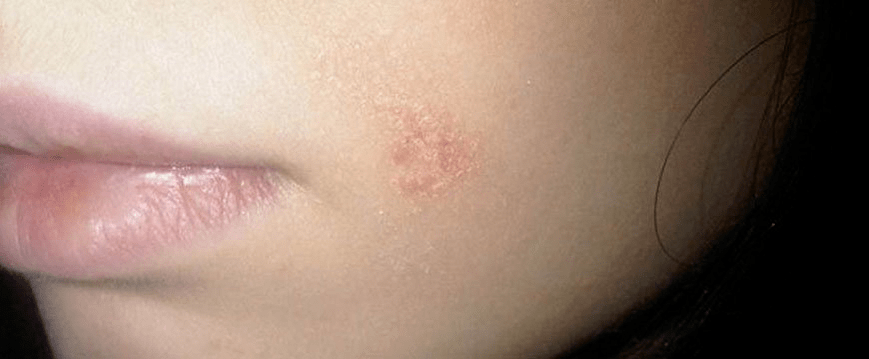
Psoriasis of the genitals
This is not an isolated process. Simultaneously with the defeat of the genitals, there is a special psoriatic rash all over the body, so it is not difficult to identify the disease.
Psoriasis on the penis in men and labia majora in women, as well as on nearby areas of the skin, manifests itself in the form of pink scaly papules that rise slightly above the skin. Almost no itching. Sometimes the process spreads to the mucous membranes and looks like vulvovaginitis in women and balanoposthitis in men.
Atypical psoriatic rash can be seen in obese people in the folds located next to the genitals (inguinal, intergluteal). Here, areas with a strong red color with a mirror -like surface are formed with no signs of flaking due to constant wetting.
What are the dangers of psoriasis and does it need to be treated
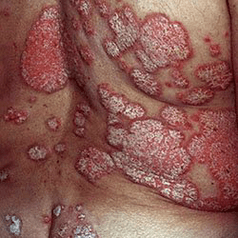
The danger is that psoriasis can spread to a severe form, the rash will occupy more than 10% of the body part. The stage of the disease is difficult, recurrence, the elements of the rash are injured and wet, the infection is often combined. Only in the prescribed time can psoriasis treatment stop the process of its spread.
Sometimes the disease is complicated by inflammation of the joints with the formation of psoriatic arthritis, in which joint function can be significantly impaired.
Against the background of systemic autoimmune processes, which have a significant impact on the patient's condition, other autoimmune diseases often develop (rheumatoid arthritis, some types of arthrosis, Crohn's disease, etc. ), as well as severe cardiovascular pathology, diseases of the digestive system, neurological reactions.
If you do not start psoriasis treatment on time, the patient’s condition will dramatically worsen and result in disability.
There are also complications such as psoriatic erythroderma, which develops with improper or inadequate psoriasis treatment, as well as when various irritating factors are exposed to the inflamed skin. The skin acquires a bright pink color with a clear restriction of the affected area from the healthy, exfoliation of small and large lamellae. Such patients require emergency medical treatment.
Is psoriasis treatable?
Yes, and successful, but full recovery cannot be guaranteed.
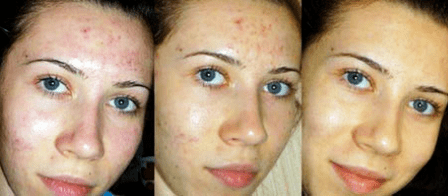
Methods of treatment
Autoimmune inflammation requires individually selected complex therapies, lifestyle changes, diet, and elimination of all bad habits. Modern medicine has proposed three basic principles for successful psoriasis treatment:
- strict adherence to algorithms for prescribed therapies;
- periodic monitoring of the effectiveness of therapy;
- timely prescribed correction of therapy with insufficient effectiveness.
Nutrition for psoriasis
There is no special diet for psoriasis, but nutrition is very important. Therefore, when prescribing a complex treatment, recommendations on nutrition must be given:
- identify increased body sensitivity to certain foods and exclude them from the diet;
- prefer fresh vegetables, non-acidic fruits and berries, boiled and baked lean meats, drink more;
- what not to eat with psoriasis:
- products containing essential oils - onions, garlic, carrots;
- beverages containing caffeine (concentrated tea, coffee), alcohol;
- everything is more salty, sour and sweet, rich;
- products that induce sensitization (allergy) of the body - oranges, honey, nuts, cocoa, eggs;
- do not eat fatty animal products.

Pegano diet for psoriasis
This diet was developed by American physician John Pegano, but has not yet gained official medical recognition. The principle of building the Pegano diet for psoriasis is associated with alkalinization of the body by choosing the right diet. According to this principle, all products are divided into:
- alkaline formers (two -thirds in the daily diet) - a mixture of fruit and juice and acidic juices, vegetables (excluding those that cause increased gas formation);
- acid -formers (a third of the diet) - meat, fish, dairy products, nuts, peas, potatoes, cereals, sweets and pastries.
Patients are advised to drink mineral water without gas, drink up to 1. 5 liters of water per day, plus other beverages consumed (compote, juice, etc. ).
Drug therapy
Mild psoriasis is treated with topical medications. Severe and rapidly progressive forms of the disease are treated primarily in hospitals with the prescription of general action (systemic) drugs.
External psoriasis treatment
This medication is chosen by a dermatologist. For psoriasis vulgaris with dry narrowing plaques, ointments are suitable, if removing fluid (with seborrheic), then creams and medicinal solutions are used. To prevent the resistance (resistance) of an organism to a particular drug, it changes over time.
In the acute (progressive) stage, the following external therapies are performed:
- agents that have a softening effect - boric petroleum jelly, 2%salicylic ointment;
- effective non -hormonal ointment for psoriasis containing active zinc pyrithionate; they suppress infection and have a cytostatic effect (suppression of tissue proliferation);
- external agents containing glucocorticosteroid hormone (GCS);
- combined agents with calcipotriol (vitamin D3 analogue) and the corticosteroid betamethasone; perfectly suppresses the inflammatory process.
External psoriasis treatment at stationary stage:
- ointment that dissolves scales (keratolytic) and has anti-inflammatory effect-5% naphthalane, boron-naphthalane, tar-naphthalane;
- corticosteroid drugs.
External treatment of psoriasis at the solution stage:
- the same keratolytic ointment, but in higher concentrations: 10%tar-naphthalane ointment;
- ointment based on vitamin D3 analogues - within 6 - 8 weeks; suppresses the inflammatory process and exfoliation of the rash.
For the treatment of nail psoriasis, special varnishes are used that suppress the development of pathological processes. It is recommended to treat the periungual phalanges with a moisturizing gel.
Treatment of systemic psoriasis
- drugs that relieve inflammation and intoxication - calcium chloride, sodium thiosulfate, unitiol in the form of injections;
- tablets for psoriasis, which suppress the process of proliferation (multiplication of epithelial cells) - cytostatics that suppress the activity of the immune system, vitamin A analogues, corticosteroid hormones;
- biological agents containing human monoclonal antibodies of the IgG class, act on specific inflammatory links by suppressing cytokine synthesis; it is a highly effective modern medicine given by injection;
- vitamins for psoriasis help restore the metabolism and keratinization of epithelial cells; The doctor prescribes vitamins A, E, D3, group B.
Folk remedies for psoriasis
Any treatment for psoriasis, including with the use of folk remedies, can only be prescribed by a doctor. Treatment alone can lead to the opposite effect: the spread of the disease.
As part of a complex therapy, the following methods can be used:
- gray- industrial oil processing products; to prepare the ointment, you need to buy a medicinal solid oil at the pharmacy; recipe: in 0. 5 kg of solid oil, add 50 g of honey and half a pack of baby cream; procedures are performed daily; at the pharmacy, you can buy ready -made preparations based on solidol.
- baking powder- folk remedies for psoriasis, which help clear the crust, relieve itching; recipe for application of soda: take 60 g of soda, dissolve in 0, 5 liters of water, soak gauze in the solution, fold it in several layers and apply to the lesion for 20 minutes; after the procedure, rub the skin and apply an emollient ointment on it; psoriasis treatment with soda is carried out once a day;
- mummy- has a pronounced anti-inflammatory effect, relieves itching well; can be taken orally once a day, 0. 2 g for two weeks; external therapy is carried out with mummy solution; it is used to dry itchy plaques twice a day; treatment of psoriasis on the head is done by rinsing the scalp with a solution of mummy after washing;
- sea salt- relieves inflammation, itching well; bath with sea salt: take 1 kg of salt, dilute in two liters of water and add to the bath; bathe for 15 minutes, then rinse the solution under a warm shower, dip the body with a towel and apply an emollient ointment; treat psoriasis by bathing no more than twice a week;
- clay- has a significant cleansing effect, absorbs its surface toxins formed as a result of inflammation and improper metabolism; helps dry, remove crusts and itching; you can take clay, but it is better to buy blue clay at the pharmacy; pieces of clay must be well dried, broken with a hammer, diluted with water and left to stand for several hours; place the resulting plate -like clay on a napkin (up to 3 cm thick) and apply on the inflammation for three hours; to treat psoriasis with clay on a daily basis.
Important: the treatment of psoriasis at home with folk remedies should be done carefully and strictly according to the doctor's prescription. Such treatment will help one patient, while another can cause swelling and rapid spread of inflammation. Therefore, if, against the background of therapy, the patient's condition worsens, it is necessary to immediately stop it and see a doctor.
Home treatment for psoriasis
While treating psoriasis at home, it is important to follow dietary recommendations, lead a healthy lifestyle, exclude bad habits and follow all dermatologist prescriptions.
How to cure psoriasis at home? A number of patients try to cleanse themselves of toxins and poisons using a variety of unconventional methods (enemas, etc. ). This can give the opposite result: the work of the digestive tract will be disrupted and deterioration will begin. Modern medicine recognizes cleansing the body in the form of proper nutrition and getting rid of bad habits.
It is important to follow all doctor’s prescriptions and pay attention to how the prescribed therapy works. If not effective enough, the doctor will replace the treatment, achieving maximum therapeutic effect.























